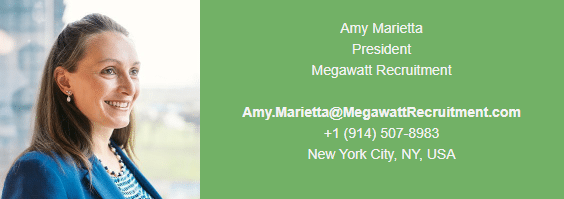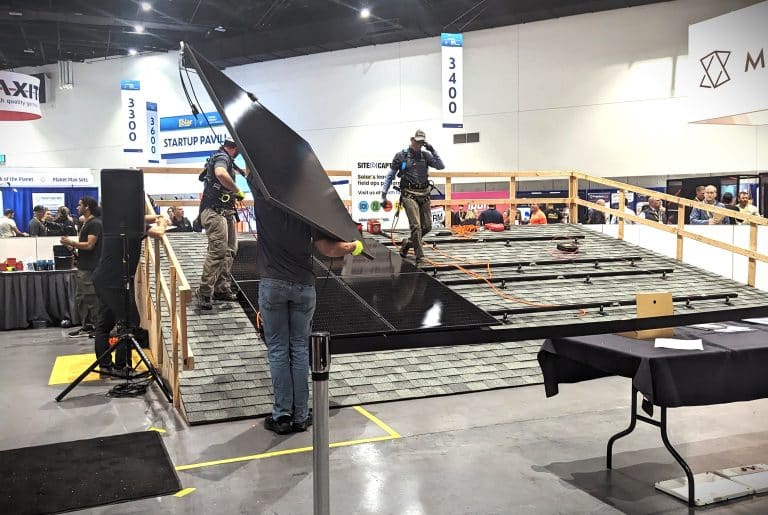Interconnection: Renewable Energy USA
Welcome to Megawatt Recruitment’s monthly newsletter to keep you connected to what’s going on in the renewable energy industry in the United States and provide more insight, knowledge, and connection to the people and companies who drive our industry.
What People Are Talking About
- New York awarded its 4th offshore wind tenders to Equinor and Orsted for the 810MW Empire Wind 1 project and 924MW Sunrise Wind project respectively.
- DTE, Michigan’s largest electric utility and one of the largest in the U.S., will take bids until May 14th to build just over 1GW of renewables to support its decarbonization efforts.
- The DOE announced projects selected for award negotiation for $366 million of funding to accelerate clean energy deployment into remote and rural areas with muGrid Analytics snagging a spot as Lead Program Manager of nearly $10 million in federal funds to deploy microgrids and its Redcloud Energy Management System into 24 sites in Northern Wisconsin.
- On February 13th, the BOEM announced two zones in Oregon for offshore wind development covering 195,000 acres with a capacity for 2.4GW of energy.
- Generate Capital, a leading sustainable infrastructure platform, raised $1.5B of equity. Renewable energy companies in its investment portfolio include Nexamp, Pine Gate Renewables, and esVolta.
- Massachusetts-based FirstLight Power, a developer and IPP focused on solar, battery storage, offshore wind, and hydropower completed the acquisition of Quebec-based Hydromega Services Inc, including ownership interest in 5 hydropower generating stations, and 2GW of projects in the pipeline, bringing FirstLight’s development pipeline up to 4GW.
- ENGIE North America raised $1B of tax equity for 1.3GW of projects.
- The Center on Global Energy Policy released an analysis of the BIG WIRES Act, which was introduced in Sep 2022, that would direct the FERC to mandate interregional (within U.S. states) electricity transfer requirements, and believes this kind of energy sharing would grow capacity by 191GW or 126% by 2035.
- Australian company 5B, a manufacturer and installer of prefabricated, pre-wired ground mount solar arrays, closed the doors to its U.S. operations.
- DOE released a report noting that mass deployment of geothermal heat pumps in single family homes could save the U.S. as much as 24,500 miles of new grid transmission lines by 2050. Imagine what the savings could be if we deployed more geothermal district heating and cooling!
- In BESS news, Strata Clean Energy secured $559M for 1GWh in AZ and Spearmint Energy secured $47.5M for a 150MW, 300MWh for TX.
Recent Personnel Moves and Promotions
- Following the shake up or Orsted last year, the following appointments are set to take effect April 1st, 2024:
Thomas Thune Andersen, currently Chair of the Board of Directors (BOD), will not seek re-election. He holds other board positions at Lloyd’s Register, VKR Holding, and BW Offshore
Lene Skole, currently Deputy Chair of the BOD and CEO of Lundbeckfonden will become Chair of the BOD
Andrew Brown, currently Interim COO will become Deputy Chair of the BOD
Patrick Harnett, currently Head of European Execution Programmes and Head of Project Development and Construction of Hornsea 3 will become COO.
Rasmus Errobe who has been Interim CFO since Nov 14, 2023 will return to his position as Chief Executive of Region Europe by the end of March 2024 while Trond Westlie, formerly Group CFO for AP Moeller-Maersk will become CFO.
In a shake up on this side of the pond, Benjamin Fowke III, a member of the BOD of American Electric Power, a major investor-owned utility with customers in 11 states in the Midwest and southwest, will replace CEO Julie Sloat as interim CEO while AEP lead director Sara Martinez Tucker is the new board chair.
Enel Green Power’s former CEO of Enel Grids and of Enel Green Power, Antonio Cammisecra, has joined ContourGlobal, a British power producer that was taken private by KKR in Dec 2022.
- Rachel Slaybaugh joined the BOD of Fervo, a geothermal developer that recently raised $244 million in new funding, lead by Devon Energy, a pioneer in shale technology for the oil and gas industry.
RES hired a new CEO of Global Services, Juan Gutierrez, formerly CEO of Global Service for Siemens Gamesa and is based in Orlando, FL.
Aftab Khan joined PJM Interconnection as EVP of Operations, Planning, and Security based in Boston, previously with Eversource Energy as SVP of Engineering.
Dylan Reeves moved from Bluestar Energy Capital where he was Head of Commercial Operations into its portfolio company, Nova Clean Energy, as SVP of Commercial Operations. He was previously with GE Renewable Energy for 14 years and worked in their onshore wind department.
SiteTracker went on a hiring spree, continuing its trend of +/-12% y/o/y headcount growth, bringing on Dorian Scarlett as Enterprise Account Executive, Kaley Postiglione as Senior Account Executive, and Zed Haider as Account Executive
C-Power, a wave energy producer, also hired three new team members, two in R&D Engineering, Suraj Gawade and Lisa Hildebrand, and one Project Manager, Sean Sadlier.
What the market is talking about: Proposed Changes to Clean Hydrogen Production Tax Credits
2023 ended with a cliffhanger regarding tax production credits (TPC) for clean hydrogen. On December 22nd, 2023, the Internal Revenue Service (IRS) and the U.S. Department of the Treasury (USDT) proposed guidance for the TPC. Since then, we have been in the public comment period, which will conclude March 25th, 2024 with a public hearing. Currently, the 45V tax credit provides a credit of up to $3/kg of hydrogen that is produced with low lifecycle gas emissions. The guidance goes on to propose:
- How producers should calculate the lifecycle emissions
- Procedures for producers to petition for a provisional emission rate if their production model is novel and not already outlined in the 45Vh2-GREET model
- That producers using electrolysis must use energy attribute certificates (EACs) that show evidence that the electricity is used specifically for the production of hydrogen by being time-matched, is specifically delivered to the electrolyzer, and is incremental to existing power generation (ex: is being sourced from new clean power plants).
- How retrofitting or modifying existing plants can qualify them for TPC
- Clarifies that the 45V credit is available even if the hydrogen is sold outside of the USA
A discussion that we expect to hear more about at the public hearing at the end of March includes whether blue hydrogen technologies will pursue 45V or 45Q credits. Blue hydrogen sources include steam methane reforming, autothermal reforming with carbon capture and sequestration, and renewable natural gas. These have existing policy support by means of the 45Q credit of $85/ton of captured CO2 but could choose to pursue the 45V instead.
Additionally, the American Clean Power Association believes that Regionality and Additionality should play a role. Regarding Regionality, it believes that the energy powering the electrolyzer should come from power that is on the same grid or potentially even more locally with the aim of “balancing” clean sources and conventional sources in a given area. They also believe that there should be a component of needing to offset new grid power consumption. What this tries to avoid is an electrolyzer creating new power on a grid that is already completely green, hence, not actually offsetting emissions from a new load on the grid.
We will be following up on this in our March issue of Interconnection: Renewable Energy USA.
Talent Acquisition Insights: International Women’s Day’s Theme for 2024: Inspire Inclusion
Friday, March 8th is International Women’s Day (IWD). Some readers might not know that the first IWD traces its roots back to 1908 and has a rich history.
Each year, there is a new campaign theme for IWD and 2024’s is: Inspire Inclusion. According to the IWD website, “When we inspire others to understand and value women’s inclusion, we forge a better world. And when women themselves are inspired to be included, there’s a sense of belonging, relevance, and empowerment” with a call to action of “Collectively, let’s forge a more inclusive world for women.”
In our industry of clean energy, there are many statistics about the lack of women pursuing careers in clean energy and renewables. For example, at the InterSolar North America (ISNA) conference in San Diego this past January, I was shocked to hear during a panel discussion that the clean energy workforce is 70% male and 70% white, while another panelist chimed in that only 2% of electricians are women.
Before we can start to debate the questions of “Why aren’t there more women in the sector?” and “What can we do to attract more women?,” let’s further refine different categories of clean energy. On a high level, the International Energy Agency breaks “clean energy” down nicely into 8 sectors: Energy Efficiency, Power Generation, Vehicles, Grids, Bioenergy, End-use renewables, Innovative Technologies, and Critical Minerals.
When we look at the types of jobs within these sectors, we can imagine that many of these jobs require hands-on work and heavy lifting. For example, an average residential solar panel weighs about 40 lbs and must be carried up a ladder, sometimes up multiple stories. A contractor’s wheelbarrow full of wet concrete generally weighs around 450 lbs, and might be used by an EV charging company to build a dock for a charging point. We can continue to imagine all the heavy things that are required for upgrading HVAC systems and assembling electric vehicles as well as the upper body strength required by companies that require workers to climb ladders to perform maintenance and repairs such as with wind turbines and transmission lines.
There is nothing to say women cannot perform these jobs. As a woman, a West Point grad, Air Assault School graduate, and the 2010 FOB Sharana female bench press champion, I have full faith and confidence that all of the above tasks could be performed by women but I also acknowledge that there are physiological differences between men and women that may make those jobs proportionally more difficult, and hence, undesirable for women as a long term career path.
However, if you read our January newsletter, you’ll find that one of the trends we are watching in 2024 is the rise of robotics across renewables. So, what if we could install a 100MW ground mounted solar farm using only our thumbs? Well, that is exactly what some companies believe they can do with a combination of drones, robots, and a remote controllers.
Your next question might be “Well, would women even want to do those kind of jobs?” In my opinion, the answer is yes! In another industry that is underrepresented by women, the gaming industry, a recent survey shows that 46% of gamers in the U.S. are women. Data from the Federal Aviation Administration also shows huge growth in the number of women with remote pilot certification (ex: drones, UAVs) with the number of female remote pilots increasing nearly 3000% since 2016. So, it would seem that many women are happy and comfortable working from behind a remote control.
So, I will wrap this article up by saying: As you think about how you will Inspire Inclusion in 2024, try to think outside of the box as to how new technologies can help women overcome traditional barriers and allow them to contribute to the clean energy revolution.
Hot jobs: View our posts and Apply Now!

Thank you for joining us for another issue of Interconnection: Renewable Energy USA. We hope you enjoyed it and we look forward to keeping in touch and exchanging ideas, insights, and opinions. If you are a company considering hiring, we welcome the opportunity to present our services and capabilities. If you are a candidate, please check our jobs page or reach out to us to discuss your background, skills, and future aspirations.

